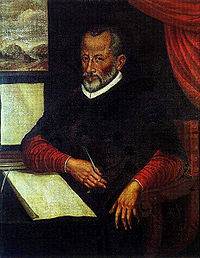I wrote this blog a few years ago and posted it on another site that I only used very briefly, and honestly kind of forgot about it until today. I came across the blog and thought I’d re-post it. It was mostly a blog about the Pope Marcellus Mass of Palestrina, but also gets in to the topic of what is the difference between our rock/pop music and classical music – a question that when I was starting out as a “classical” composer I would often ask, but never got answered. I thought for a long time about it, mostly because I’m the kind of person that feels like I have to really fundamentally understand something to really do it, and I finally came up with an answer that satisfied me. If you’re really interested, you can read the stuff about Palestrina too.


Today I focused on determining the overall “key” of the Pope Marcellus Mass. This can be a somewhat difficult task, for many reasons. For one, the concept of “keys” did not exist in the 15th century as we think of them today. Music was based on a system of “modes”, and mode was determined by the range and melodic activity of the “tenor” – which was considered to be the most important voice in the choral texture. It’s strange to us, because this voice was in the middle of the texture. Our ears are always focused on the highest voice as being the most important – this comes from our perception of music being separated into a vocal and accompaniment – a concept that also didn’t exist during Palestrina’s time.It’s hard for us, living in 2009, to relate to this way of thinking, or even to understand it. Our society is surrounded by popular music – it’s our vernacular music, and it’s how we think musically. People often ask the question, “What’s the biggest fundamental difference between pop music and classical music?”.
My simple answer: pop music comes from a harmonic tradition, and classical music from a melodic tradition. So, what does that mean? When we write music, we think vertically (like a stack of notes – a chord) – we chunk, chunk, chunk out chords – we think in chordal relationships – this chord goes to that chord, etc – or I to V to I – whatever terminology you want to use. In classical music – especially music written before 1600 – music was thought of as separate, independent lines that could work together to create a tapestry of polyphonic sound – like threads woven together. The concept of “chord” didn’t exist – chords as we think of them were merely points of rest where the separate lines would converge after a moment of tension and activity. This is the way composers thought – from Palestrina to Bach to Mozart to Beethoven – this is the fundamental basis of “classical” music, and the biggest difference from our modern pop music.Coming to this realization was HUGE for me as a composer. No one had ever really explained this difference, and since I too came from a rock/pop background, I struggled for years with understanding classical music from a really fundamental level.Anyway, I kind of digress from my topic of Palestrina’s Pope Marcellus Mass – but it is important to understand how he thought of music to understand how he composed, and how he thought of “key” – which he would have called “mode”.We still use modes today, but essentially only use 2 – “Ionian”, which is our “major” scale, and “Aeolian”, which is our “minor” scale. There are 5 other modes though that you sometimes hear, although hardly ever in popular music. A good example of a different mode would be the very first three notes of Danny Elfman’s theme from the Simpsons – very clearly in the “Lydian” mode.Just to further complicate things, the medieval church modes were quite antiquated by Palestrina’s time. By 1547, the 16th century music theorist Glareanus had already put forth a theory of 12 modes (which is closer to our modern system of keys – 12 major and 12 minor). So, although there wasn’t a concrete tonal system of keys yet, composers were already moving in that direction, while at the same time still observing some principles of the old modal system.
So, lets get down to business and look at where the different sections start and end:• Kyrie I – Mixolydian (G major) to Ionian (C major)• Christe – Ionian to Mixolydian• Kyrie II – Mixolydian to Ionian• Gloria – Mixolydian to Ionian• Credo – Mixolydian to Ionian• Sanctus – Ionian to Ionian• Agnus Dei I – Mixolydian to Ionian• Agnus Dei II – Mixolydian to IonianIn typical tonal music that we are all most familiar with (this goes for classical music as well as pop music), you would typically have the piece, song, whatever start and end with the same harmony. So, if a piece is in C Major, it would typically begin with a C Major chord, and end with a C Major chord. However, as you can see, Palestrina hardly ever does this (only in the Sanctus). So, what mode is it in? If we go by how he starts the section, it looks like it’s in the Mixolydian mode (we would say G Major). If you go by the END of each section, it’s clearly in the Ionian mode (we would say C Major, although Palestrina would never have thought in that way). So, which one is more important – the beginning or the end? Having established that the tonal system did not yet exist, we have to assume that Palestrina was still following many of the conventions left over from the medieval system of modes. One of the conventions of determining mode was the FINAL, or last note of the plainchant – and very often (it was the norm actually) for the plainchant to start on a note other than the final. So, observing this convention, we can safely say that the intention is Ionian mode for the Mass. Damn – all that just to find out what key it’s in!
That’s cool man.Really explains it a little more in depth then we can get in class.
Very interesting. I’m curious as to how you would classify minimalist composers like Glass, Adams, Reich, and Part, or ambient composers/producers like Brian Eno. Offhand, Glass and Adams strike me as “chordal,” Reich (especially in works like “Tehillim”) and Part “melodic.” What do you think?
I would totally agree with you about Glass and Adams being more harmonic, and Reich and Part more melodic. It’s interesting to see that the later we get in classical music, the more we can see these lines of separation blurring.
Am currently writing about palestrina for educational purposes. Can I use some of your points of comparison in my work? Thanks
Sure! Just give me credit 🙂 What is your paper about?
Thanks.. Its a learning module in music we are currently developing for grade 9. Your permission is highly appreciated.
I like the way you presented your views. Its practical. You dont have to be a music scholar to understand your view. Which is one of the objectives of our module. Presenting Western Music History the simpler way.
Very cool – I’d love to read the module when it’s finished!